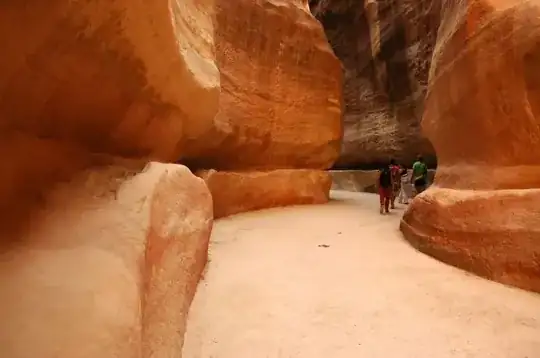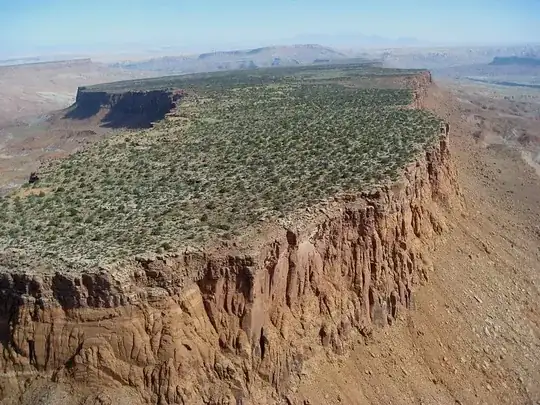If these places exist simply to provide a location for the caravans to recover, they will just be tiny outposts rather than cities. In order for these to be cities, they would need to be largely self-sufficient, as well as have some reason for existing. A person eats a lot of food in a month, but thousands of people eat truly enormous quantities. People in the desert also need significant amounts of water per day - hot dry climates take it out of you faster than you think. This is implausible to supply via mammoth camels. Food for a handful of outpost guards I could believe, but more than that becomes problematic (the more people need to be supplied, the lower the capacity for actual trade goods, and the higher the overhead cost - each pack animal will need more fodder as well, meaning additional carried food or farmland).
What kind of desert are we talking about? Is this endless giant shifting sand dunes like the Sahara or semi-desert hard scrub like the Kalahari? Regardless of the geology, you will need to think about the ecology of the desert. How do these dangerous animals roaming the desert get enough food and water to survive when there isn't a handy desert mammoth wandering by? Whatever water source you use is going to be an incredible draw for local wildlife (and was before the city developed), as are any crops being grown.
These locations are going to need generous sources of fresh water as well as some good soil for growing food for the city (both to feed the people and fodder for the animals unless they can make the entire trip without eating, which seems iffy). This could either be a cluster of waterholes developing a biome for a large area of arable land, a floodplain on a river (could be only temporarily above ground), or go with something a little more exotic like using some deep-rooted trees to grow food and provide water (tapping trees for water being a very intensive use). The less rich the soil and less plentiful the water, the more farmland will be needed per person for food - the exotic trees example would require massive amounts of territory to support a city, so probably only in a 'safe' area of the desert without many dangerous animals (or at least safe enough a small contingent of camel cavalry could protect roving bands of harvesters outside the city walls).
How is the city constructed? What materials are they built out of? Clay/mud bricks or stone? Almost certainly locally sourced as shipping building materials would be ruinously expensive. How the cities are built will be entirely dependent upon their location - perhaps scattered watering holes supporting some farming plots (or dug wells with smalelr gardens) would be surrounded by a large ring of houses (farming in the protected courtyard within the communal walls of adjoining buildings) as the city itself ending up with a streetless honeycomb plan like Çatalhöyük where the outer walls of the houses were effectively the city walls (no need to expand some arbitrary city walls, use the roofs as streets, and no real worries about animals who don't climb ladders). Expansion is as simple as building one new house at a time - eventually you will close off a new safe area in which to dig another well and have more gardens (so long as the water is plentiful).
Sanitation will be a major concern, and all resources will be precious - feces will certainly be needed as fertilizer (urine for ammonia too), so illness is a serious issue.
Foods would be beer and thoroughly boiled gruel (killing bacteria in tainted water and fecal contaminated veggies).
Basically just think of the geology (the soil/sand/rocks and the river/oasis/wells) which informs the ecology (how do the wild animals survive) as well as the construction of the cities (on a riverside or lake, on top of wells, surrounding a spring, etc).
Walls will depend on what threats they face - thick or thin (small animals or herds of wild mammoths desperate to batter their way through?), unmanned or heavily patrolled (dumb non-climbing animals or climbers who don't slow down at vertical surfaces - solitary animals or in swarms?).
Transport across seemingly endless and very dangerous desert is expensive, so what is worth the effort of doing it? Why do so many people live there when it is so hard to survive?
The possibilities are endless, so break it down to the most basic level and build up logically with an eye to ecology and economics.

